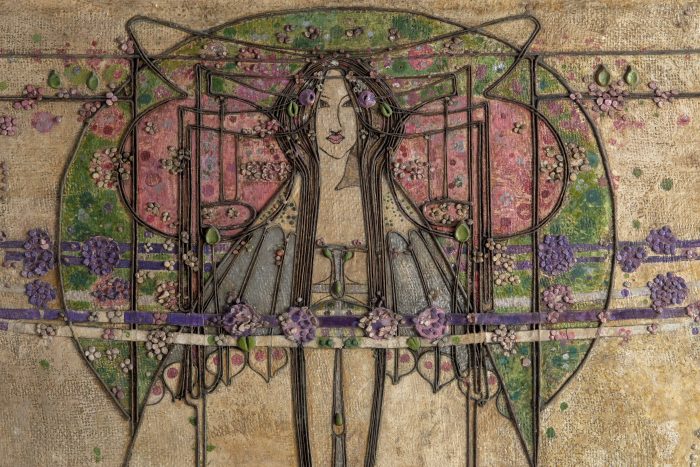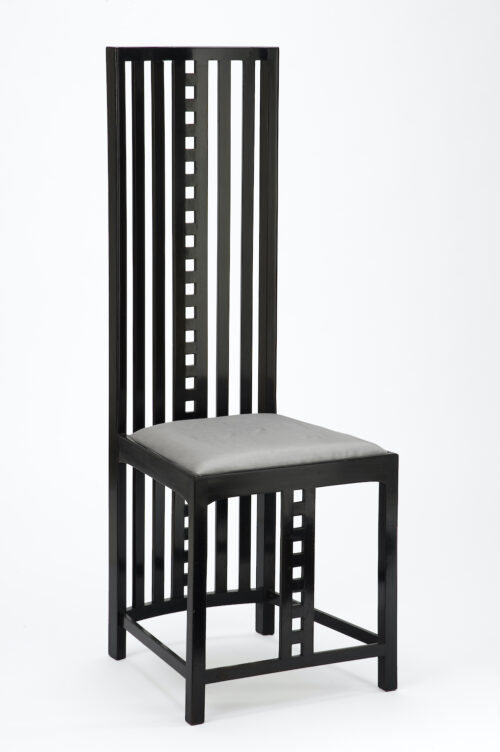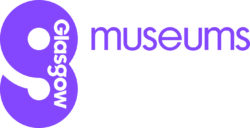June 11–September 12, 2021

NASHVILLE, Tenn. (April 14, 2021)—The Frist Art Museum presents Designing the New: Charles Rennie Mackintosh and the Glasgow Style, an immersive exhibition that showcases Charles Rennie Mackintosh—the greatest exponent of the Glasgow Style—as an architect, designer, and artist, and contextualizes his production within a larger circle of designers and craftspeople in Scotland’s largest city. Co-organized by Glasgow Museums and the American Federation of Arts, the exhibition will be on view in the Frist’s Ingram Gallery from June 11 through September 12, 2021.
At the end of the 19th century, the Glasgow Style emerged as the major manifestation of Art Nouveau in Britain. Combining influences from the Arts and Crafts movement, Celtic Revival, and Japonism, Glasgow artists created their own modern design aesthetic, synonymous with sleek lines and emphatic geometries expressed in a wide range of materials.
This exhibition presents 165 works of fine and decorative art in a wide variety of media, including architectural drawings, books, ceramics, furniture, posters, textiles, and watercolors, drawn from Glasgow’s most significant public and private collections. Videos provide guests with tours of buildings designed by Mackintosh and his contemporaries.
Charles Rennie Mackintosh (1868–1928) is one of the most significant architects of early modernism, and Designing the New places his work into the context of Glasgow circa 1900, during the industrial city’s heyday. In 2018 Glasgow Museums organized this exhibition to celebrate the 150th anniversary of Mackintosh’s birth, and this is the first major Mackintosh exhibition in the United States since 1996. “Designing the New is a landmark in the study of his career and offers a rare opportunity to see the art of Mackintosh and his contemporaries outside of his native city,” says Frist Art Museum senior curator Trinita Kennedy. “We are thrilled to introduce the work to our guests or further their knowledge and appreciation of the Glasgow Style’s impact and legacy.”

As the most ambitious and inventive proponent of the Glasgow Style, Mackintosh is often compared to Frank Lloyd Wright, who was almost his exact contemporary. Mackintosh made his mark on Glasgow and its environs with his designs for a variety of buildings, including a church, houses, offices, schools, tearooms and, most important, the Glasgow School of Art, which is currently being rebuilt after two devastating fires. “Interest in Mackintosh has increased over the last thirty years, and architecture and design enthusiasts go on pilgrimage to Glasgow to see his buildings,” says Kennedy.
The show’s chronological narrative spans Mackintosh’s entire life, presenting his work in the context of his predecessors, contemporaries, patrons, and friends in Glasgow. “Informed by decades of research by curator Alison Brown of Glasgow Museums, this exhibition offers a penetrating new interpretation of Mackintosh that shows he was far from an isolated genius,” says Kennedy. Mackintosh worked most closely with his wife, Margaret Macdonald; Margaret’s sister, Frances Macdonald; and Frances’ husband, James Herbert McNair. They met as students at the Glasgow School of Art in 1892 and together were known as The Four. “Learning their craft in the school’s technical studios, they often worked collaboratively and applied their deliberately eccentric and bold artistic vocabulary to all fields of decorative design,” says Kennedy.
A significant number of women artists played integral roles in the movement. “Glasgow was a progressive city, especially in terms of public education, and some women were able to forge careers as artists. Women teachers and students at The Glasgow School of Art often continued working even after they married and had children,” says Kennedy. A few of these same women were also suffragists (full voting rights were not granted to women in Great Britain until 1928).
Among the highlights of the exhibition are interior design elements for entrepreneur Catherine Cranston’s famous Glasgow city-center artistic tearooms, including the monumental frieze The May Queen and an aluminum and copper pendant light. A high-backed chair that Mackintosh designed for the Hill House in Helensburgh—considered to be his domestic masterpiece—is one of several iconic chairs in the exhibition. His chairs entered mainstream pop culture with appearances in movies such as The Addams Family, Blade Runner, and Star Trek, and Madonna’s “Express Yourself” video.

Programs
Friday, June 11
Curator’s Perspective
The Acme of Originality—Charles Rennie Mackintosh’s Cutting-Edge Tearoom Designs presented by Alison Brown, curator for European decorative art and design from 1800, Glasgow Museums
Noon
Presented on Zoom;
Free; Registration required.
Sign up at FristArtMuseum.org/events.
Over a 21-year period, between 1896 and 1917, the architect and designer Charles Rennie Mackintosh created some of his most imaginative interiors and decorative schemes for Catherine Cranston’s four tearooms in central Glasgow. These commissions provided him with crucial opportunities to experiment with an increasingly sophisticated approach to interiors, furniture, and fittings, from mysterious murals inspired by Art Nouveau and Japan and iconic high-backed chairs to atmospheric dining spaces with palettes ranging from white-and-silver to warm stained wood, along with Chinese-influenced designs and boldly colorful geometry that anticipated the rhythm of Art Deco. His most three-dimensionally conceptual suite, for the Willow Tearooms (1903), achieved a new level of fashioning an interior as a total work of art. This illustrated talk presents Mackintosh’s unique collaborations with Cranston through archive and object photographs, with behind-the-scenes insights from Glasgow Museums’ conservation, reassembly, and restoration of some of his surviving tearoom interiors from Ingram Street.
Alison Brown has worked for Glasgow Museums since 1993. Her particular focus is on the work of Charles Rennie Mackintosh, the Glasgow Style, art education, and decorative art and design from the 1860s through the 1950s. She curated the exhibition Charles Rennie Mackintosh: Making the Glasgow Style, which marked the 150th anniversary of Mackintosh’s birth in 2018 with an inaugural showing at Glasgow’s Kelvingrove Art Gallery and Museum and subsequent presentation at the Walker Art Gallery in Liverpool, England. She then adapted it into Designing the New. Brown has contributed articles and essays to numerous books and journals, including The Flower and the Green Leaf: Glasgow School of Art in the Time of Charles Rennie Mackintosh (2009), Glasgow’s Hidden Treasure: Charles Rennie Mackintosh’s Ingram Street Tearooms (2004), and the catalogue for Designing the New (available in FAM’s gift shop). She is vice chair of the Charles Rennie Mackintosh Society and editor of its journal.
Catalogue
Designing the New: Charles Rennie Mackintosh and the Glasgow Style is published by DelMonico Books●Prestel, in association with Glasgow Museums (2019). This lively and informative book showcases the work of Mackintosh and contextualizes it in relation to a larger circle of designers and craftspeople with which he shared sources, stylistic features, and patrons. Filled with color illustrations, archival materials, and essays, this volume explores every aspect of the Glasgow Style—from beautifully appointed homes and restaurants to everyday works of needlepoint, cups, and saucers, stained glass windows, magazine illustrations, and textiles. Far-reaching and influential, the Glasgow Style impacted nearly every facet of daily life.
Exhibition Credit
Designing the New: Charles Rennie Mackintosh and the Glasgow Style is a touring exhibition co-organized by Glasgow Museums and the American Federation of Arts. The exhibition comprises works from the collections of Glasgow City Council (Museums and Collections), with loans from Scottish collections and private lenders. Support for the US national tour is provided by the Dr. Lee MacCormick Edwards Charitable Foundation.



Supporter Acknowledgment
Platinum Sponsor: HCA Healthcare/TriStar Health
Hospitality Sponsor: Union Station Hotel
Education and community engagement supporters: The Windgate Foundation and First Horizon Foundation
Spanish translation sponsor: Vanderbilt Center for Latin American Studies
Supported in part by the Frist Art Museum’s Friends of the Arts of Scotland
The Frist Art Museum is supported in part by The Frist Foundation, the Metro Nashville Arts Commission, the Tennessee Arts Commission, and the National Endowment for the Arts.
Read about the Frist’s health and safety procedures.
Connect with us @FristArtMuseum #TheFrist #FristGlasgowStyle
FOR ADDITIONAL INFORMATION
Buddy Kite: 615.744.3351, bkite@FristArtMuseum.org
Ellen Jones Pryor: 615.243.1311, epryor@FristArtMuseum.org
